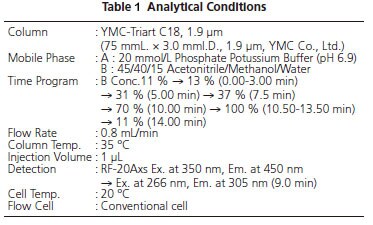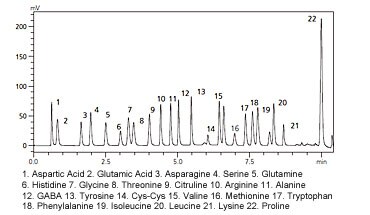High Speed, High Resolution Analysis Analysis of Pre-Column Derivatized Amino Acids by the Nexera SIL-30AC Autosampler
Amino acid analysis is required in a wide range of fields, including foods and pharmaceuticals, and various methods of derivatization have been devised to improve sensitivity and selectivity when conducting amino acid analysis by HPLC. Here, using the RF-20Axs fluorescence detector and the SIL-30AC autosampler with its automated pretreatment functions, we introduce the analysis of amino acids using pre-column derivatization with OPA and FMOC.
Analytical Conditions

Using the automated pretreatment functions of the Nexera SIL-30AC autosampler, primary and secondary amino acids were automatically derivatized into fluorescent substances within the autosampler using o-phthalaldehyde (hereafter, OPA) and 9-fluorenyl methyl chloro formate (hereafter, FMOC), respectively. After separation of the derivatized amino acids using the ultra-high speed YMC-Triart C18 column (1.9 μm, YMC Co. , Ltd. ) , high-sensi t ivi ty detect ion was conducted using the RF-20Axs fluorescence detector. Since the OPA-derivatized amino acids and FMOCderivatized amino acids are detected at different wavelengths, simultaneous analysis was conducted utilizing the automatic wavelength switching feature.
Analytical Result

Fig. 1 Chromatogram of 22 Amino Acids (10 μmol/L Each, 1 μL Injection)
Fig.1 shows Chromatogram of 22 Amino Acids, Fig.2 shows chromatogram of analysis of a commercially available soft drink.
Table 2 shows the peak area repeatability for all 22 amino acids obtained in repeat analysis (n = 6).
Since a constant reaction time can be maintained with the automated derivatization using the autosampler, excellent repeatability can be obtained compared with pre-column derivatization by manual operation.

Table 2 Repeatability

Fig. 2 Chromatogram of Soft Drink


